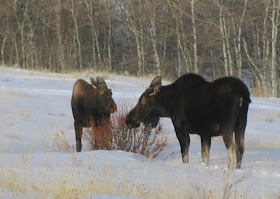Our fellow creatures have their own coping mechanisms. The pine squirrel people (aka American Red Squirrel, Tamiasciurus hudsonicus) have been rather inactive with the cold weather, and I was beginning to miss them. But warmer temperatures (it's been above 0 deg F at night) has brought them out of dormancy. What big eyes you have!

They are aptly named Tamiasciurus, which means "hoarding squirrel," as this nice November cache of pine cones demonstrates:

Now it is February. The pine squirrels dig into their cornucopias, their feasts marked by middens:

I like the chipper and industrious pine squirrel people very much. They are a good indicator for the elk hunter, for if you are moving slowly and carefully and becoming a part of the forest, the pine squirrels will not be much disturbed by you. Blunder around like the clumsy things we can be, trodding over caches and kicking fallen limbs, and the squirrel people will mark you out with their barking and buzzing alarm calls.
The moose people (Alces alces) have their own way. These twig eaters need a lot of browse, and their long legs propel them through the deep snows of the willow bottoms. But they are an upland animal, too, and in Montana are often seen along windswept ridges. This cow and calf have moved down the valley toward Walkerville from The Moulton where there is a little less snow and still plenty to eat:

Moose cows stay with their calf through most of the winter, but in mid-March or so the cows drive the "short yearling" away as they approach calving time. It must be a tough time for the calf, and you'll often see the forlorn creatures hanging out around horses in the spring, seemingly for whatever companionship they can find. This calf seems on the small side, perhaps late-born. For now at least, mom is keeping close:

RTD barks madly at cattle but seldom gives more than a little happy whine at the sight of moose, elk, or deer. How does RTD cope with winter? She says give me another dog biscuit, and I'll show you:

Now that was a fun read! Years ago when my brother was checking out the Gravelies for bow hunting and I came along (in July) to flyfish, I was so astonished find to find moose at such high elevations.
ReplyDeleteGreat photos! Love the dog in the window...
ReplyDeleteIt is amazing, troutbirder, how moose show up even in Alpine basins at c. 10,000 feet. I guess the willowy tundra is where you find it.
ReplyDeleteThanks Ruby & Miya. RTD (aka RolyTheDog) is a real poser. She tells other dogs at cocktail parties whe is a Rhodesian Ridgeback, which is not exactly true.
ReplyDeleteHoly mackeral, that's one huge squirrel trash pile! Who knew? Roly's a cutie.
ReplyDeleteHi Deedee, squirrels are very "loyal" to certain spots where they stash & eat pinecones. Sometimes they will carry cones from the cache to a particular favorite dining spot on a log or stump. - ER
ReplyDeleteLove the picture of your dog...up close and personel..also the squirrel and moose...We don't have all of that snow down here in Mississippi. It has been in the mid 70's the last two days! But the snow is really pretty tho! :)
ReplyDeleteMarian, probably no moose, either! I do love the snow especially with the cloudless days that dominate February. Moonlight ski tonight!
ReplyDeleteVery nice post and blog. Thanks for stopping by the bright idea blog!
ReplyDelete